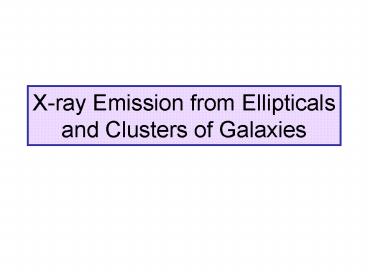Xray Emission from Ellipticals and Clusters of Galaxies PowerPoint PPT Presentation
1 / 29
Title: Xray Emission from Ellipticals and Clusters of Galaxies
1
X-ray Emission from Ellipticals and Clusters of
Galaxies
2
Summary of Results
- Isolated Es SOs have a substantial ISM in hot
gas ? spatially extended X-ray emission - Lx 1040 1042 ergs s-1 (in
E0.5-4.5 keV) - Tx 107 K
- ne10-3 cm-3
- Mgas 109 - 1010 M
Virgo E NGC 4697 Sarazin 2000
Chandra X-ray Image
optical
3
- Groups of Galaxies Clusters of Galaxies have
hot intra-cluster gas - Groups Lx 1042 1044 erg s-1
- Tx few x 107 K
- Mgas 1012 1013 M
- Rich clusters Lx 1043 1045 erg s-1
- Tx 107-108 K
- ne 10-2 10-3
cm-3 - Mgas 1014 M
- Observed out to
R1-2 MPC - metallicity 0.4
solar in Fe
4
- -- Emission is thermal bremsstrahlung from
hydrogen helium - -- Mgas 10 total mass
- -- Mgas 1-6x M(stars)
- -- X-rays trace gravitational potential in the
cluster - -- hot ICM is potentially a large fraction of
all baryons
5
Topics
- X-ray emission tutorial
- X-ray missions instrumentation
- Cluster images ? gravitational potential
- M(gas), M(total)
- Interaction between ICM and galactic ISM
- Abundances
- Cooling flows
- Origin of ICM
- Evolution of ICM with redshift
6
X-ray emission tutorial
- Emission is optically thin, free-free (thermal
bremsstrahlung) continuum collisionally
excited line emission - (1) Emissivity for thermal bremsstrahlung (see
e.g. Rybicki Lightman)
Where ne, ni number density of electrons,
ions gff Gaunt factors
Z charge of ion X-ray spectrum declines
exponentially at high energy Emissivity depends
upon T, which complicates inversion
of Sx to get n Sx n2
7
- Collisionally excited line emission
- Prominent lines at T106 -107 K
- At T108 K, only see a complex at 6.7 keV,
- blend of Fe24, Fe25 Ni
- Raymond-Smith Code
- Raymond Smith 1977 ApJS 35, 419
- Made simplifying approximations because in
1977, X-ray spectra had very low resolution - MEKAL code (Mewe et al 1995)
- CFA group (Brickhouse et al) Revisions
8
Cluster ICM Spectra as a function of
temperature (Raymond-Smith) From Sarazin (1988)
9
X-ray Missions
- Uhuru (SAS-1) 1970-1973
- Proportional counters, 2-20 keV
- Spatial Resolution 30 arcmin
- 300 X-ray sources
10
Einstein Observatory (HEAO-B) 1978-1981 0.2
3.5 keV IPC (Imaging Proportional Counter)
FOV 75x75, Spatial resolution 1, ?E/E 1
HRI (High Resolution Imager) Spatial
Resolution 2, 25 fov, No energy resolution
11
EXOSAT (ESA) 1983 1986 0.05 20 keV
1800 pointings GINGA (Japan) 1987-1991 1x2
deg Proportional Counters 1-37 keV ROSAT
1990-1998 German/US/UK 0.1-2.5 keV
All sky survey pointings PSPC Position
Sensitive Proportional Counter 30 spatial
resopution ?E/E 0.4 HRI 2 spatial
resolution ASCA (Japan) 1993-2000 0.4-10
keV Spatial Resolution 3 Gas Imaging
Spectrometer ?E/E 8 at 5.9 keV BeppoSax
(Italy) 1996-2003 0.1-200 keV
12
Chandra (AXAF) 1999- 0.1 10 keV ACIS
CCD Array HRI Gratings 0.5 spatial
resolution very low background
13
XMM-Newton (ESA) 2000 EPIC CCD Array
0.1-15keV 6 spatial resolution Grating
simultaneous background flares Astro-E
(Japan) First launch 2000 Astro-E2 launch
2005 Array of microcalorimeters ?E 10eV
Astro E2
14
The Future Constellation-X (NASA)
Next big NASA mission after JWST? 4
identical satellites w/ microcalorimeters
High spectral resolution, low spatial
resolution XEUS (ESA) Initially, big
facility built near the space station In
conceptual design phase
15
Simulated Con-X observation of a high redshift
cluster of galaxies
A simulated 50 ks observation of a cluster of
galaxies with an X-ray temperature of 4 keV at z
0.8. A Type II supernova abundance distribution
was assumed. The abundances are determined to 10
accuracy for Si, S, and Fe and to 20 accuracy
for Ne and Mg.
16
X-ray surface brightness distribution traces the
cluster potential, gives the best measure of
the dynamical state of the cluster
smooth, symmetrical emission ? dynamically
relaxed clumpy, irregular emission ?
unrelaxed, collapsing for first time
e- e- coupling time
e- ion coupling
dynamical crossing time for cluster
sound crossing time
17
Selection of Einstein Observatory images
of Clusters (contours) on DSS images
18
ROSAT Coma cluster
ROSAT Abell 3328
19
ROSAT Large fraction of present-day clusters
are clumpy, i.e. collapsing for first
time ? O low White 1993
Nature 366,429 David, Jones Forman
1995 ApJ 445, 578 Fukugita, Hogan
Peebles 1998 ApJ 503, 518
- Chandra XMM
- ? Wealth of substructure, even in relaxed
clusters - Temperature, abundance inhomogeneities
- Holes or Bubbles coincident with radio lobes
- Sharp edges, interpreted as shock fronts
20
Abell 2125 Chandra
21
Cluster Mass determinations
Fabricant Gorenstein 1983 ApJ 267, 535
Derive the gravitational potential within which
the X-ray gas sits Assume hydrostatic
equilibrium and spherical symmetry
Where the gas pressure
And M(r) mass of galaxy or cluster within
radius r µ mean molecular weight
mH mass of the hydrogen atom
Then
Deproject Sx(r) ? ?gas(r) ? MICM(r) Measure
T(r) ? deproject ? M(r)
22
Adopt ß-models to deproject ?gas
Cavaliere Fusco-Femiano 1976
rccore radius
More realistic ? distributions, e.g. Navarro,
Frenk White (1997) CDM halos Give similar
results (Ettori Fabian 1999)
23
Analysis of Chandra data for Abell 2052Blanton,
Sarazin McNamara 2003 ApJ 585, 227
Z0.035 cluster with radio source 3C317 in
central elliptical ACIS 36ksec
24
X-ray surface brightness and beta model fit
Cooling flow
ß model
25
Fe K line
26
Tx versus R Solid points deprojected
27
M(total)
M(gas)
28
Temperature map
Abundance map
29
Radio source (contours) Superimposed on X-ray
image

